Auf den Spuren von Albert Einstein
Öffentlicher Rundgang durch das Hochschulquartier/ETH Zürich, Zentrum
Daten: 14.4.15 / 12.5.15 / 13.10.15 und 10.11.15 jeweils von 18:15-19:15 Uhr
Treffpunkt: ETH Zürich, Zentrum. Rämistrasse 101, Brunnen im Hauptgebäude
Anmeldung nicht erforderlich.
Details: www.abendfuehrungen.ethz.ch

Posted
February 27th, 2015 in Angebote, für externes Zielpublikum, Public Outreach
By
Regina Moser|
Comments Off on Auf den Spuren von Albert Einstein
APS March Meeting, March 2-6 2015, San Antonio, Texas
APS TV is an on-site conference TV channel featuring a new episode daily. It is screened around the venue, as well as in selected hotel rooms.
Wach the footprint of the Institute for Theoretical Physics at ETH Zurich.
The Institute for Theoretical Physics, ETH Zurich looks at life’s big questions. The institute provides an essential part of the education at undergraduate and graduate level in the Department of Physics and pursues a broad program of research in the area of theoretical physics.
The research activities of the institute cover a wide range of fields: mathematical physics, quantum field and string theory, particle physics, condensed matter physics, quantum information theory, computational and simulational physics and econophysics. With this program, the institute spans the breadth of theoretical physics research using a broad array of methods

Posted
February 27th, 2015 in für externes Zielpublikum, Public Outreach, Tagungen und Kongresse
By
Regina Moser|
Comments Off on American Physical Society APS
Aussergewöhnlicher Vorgang:
Ein Stern und drei dichte Gaskondensationsstadien, links, formieren sich zu einem vierpoligen Sternensystem.
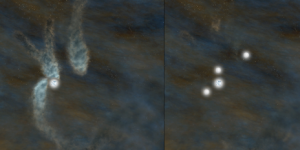
Ein internationales Forschungsteam hat im All eine neue Entdeckung gemacht: Ein sich neu formierendes Sternensystem, das aus Teilen einer fadenförmigen Gaswolke hervorgeht.
Dr. Jaime Pineda vom Max-Planck-Institut für extraterrestrische Physik ist Mitglied einer Forschungskollaboration, die das Sternensystem beobachtete sowie dessen Werden und Vergehen simulierte. Er arbeitete zur Zeit dieser Entdeckung als Postdoc am Institut für Astronomie der ETH Zürich in der Gruppe von Professor Michael Meyer, genauso wie Mitautor Richard Parker, der am Computer die Stabilität des Sternensystems bestimmte.
Zur Medienmittleilung der ETH Zürich, Deutsch/Englisch
Astronomers Catch Multiple-Star System in First Stages of Formation
Nature: The formation of a quadruple star system with wide separation
Künstlerische Umsetzung Bild : B.Saxton, NRAO/AUI/NSF
Posted
February 13th, 2015 in Announcement, für externes Zielpublikum, Public Outreach
By
Regina Moser|
Comments Off on Geburt eines Sternenquartetts
Zwei Experimente des “Wanderzirkus” gingen fremd.
Der Schwingwagen und der Wellentrog hatten am 5. Februar einen Auftritt in “Wildes Wissen“, einer Show des Wissenschaftsjournalisten Roland Fischer in der Kammer des Schauspielhauses Zürich.

Die Experimente können auch von Schulen ausgeliehen werden.
Posted
February 6th, 2015 in für externes Zielpublikum
By
Regina Moser|
Comments Off on Theater um die Physik
Treffpunkt Science City – ETH Zürich für alle.
Die spannende Welt der Forschung. Dabeisein wo neues Wissen entsteht und unsere Welt bestimmt. Vorlesungen, Demonstrationen, Ausstellungen, Laborbesuchen und Talkrunden für Erwachsene, Jugendliche und Kinder.
2015_Programmheft_Universum

Posted
February 6th, 2015 in Angebote, Announcement, für externes Zielpublikum
By
Regina Moser|
Comments Off on Das Universum 15.-29. März 2015
Am Anfang des Universums war der Urknall, sagt die moderne Kosmologie. Was war davor? Was hat den Urknall ausgelöst?
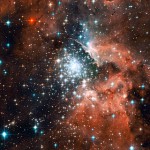
Im Museum Rietberg, 15. Februar 2015, 11-12 Uhr, Vortragssaal Park-Villa Rieter
Kevin Schawinski, Professor SNF für Astrophysik, ETH Zürich Astrophysiker und Alois Haas, Philosoph, Professor em. für Literaturgeschichte, Universität Zürich. Moderation: Rolf Probala. Tickets und Details
Bild: NASA, ESA and the Hubble Heritage (STScI/AURA)-ESA/Hubble Collaboration
Tags: Urknall
Posted
January 27th, 2015 in Announcement, für externes Zielpublikum, Lectures, Public Outreach
By
Regina Moser|
Comments Off on Vom Anfang des Universums, 15. Feb. 2015
Opportunities & Challenges of Citizen Science
22-23 January 2015, Audimax and Auditorium HG E3, ETH Zurich
free registration
Program…
Article Sonntagszeitung...
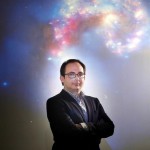
Posted
January 19th, 2015 in Announcement, für externes Zielpublikum, workshops
By
Regina Moser|
Comments Off on Citizen Science Workshop: 22-23 January 2015
Kindervorlesung im grossen Physik-Hörsaal am Campus Hönggerberg
Prof. Hans Rudolf Ott schaukelt durch den Hörsaal? Dr. Matthias George entfacht einen Feuertornado im Seminarraum? Prof. Hans-Arno Synal untersucht das Alter einer ganz speziellen Dame?
Tatsächlich! Und das alles im Herbstprogramm des “Treffpunkt Science City” zum Thema “Spitzenleistung”.
Frühjahrsprogramm 2015: Das Universum – Kurzvorlesungen, Kinderprogramm und Experimente finden am 15., 22. und 29. März 2015 statt.
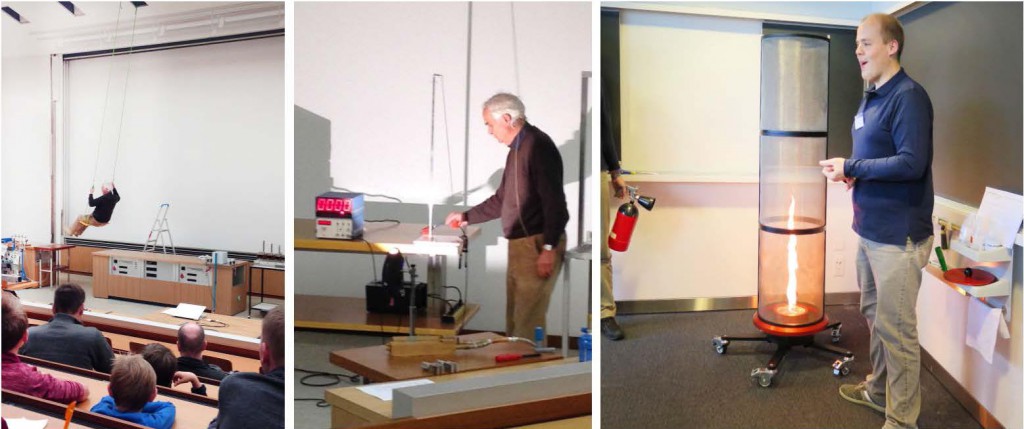
Bilder: Ulrike von Groll
Posted
December 12th, 2014 in Announcement, für externes Zielpublikum
By
Regina Moser|
Comments Off on Pendel und Feuertornado
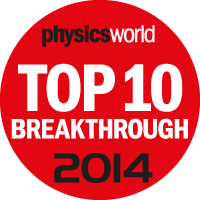
Cosmic web filament discovery hailed among top ten breakthroughs in physics of 2014
An astronomical discovery made by Sebastiano Cantalupo, who recently returned to ETH as Oberassistant at the Institute for Astronomy, has been identified by “Physics World” as one of the top ten breakthroughs in Physics of 2014. While at the University of California Santa Cruz, Cantalupo led a team that discovered an unprecedentedly large Ly-alpha nebula around one of the brightest quasars in the sky, at a redshift z = 2.3. The nebula is so large that it is being hailed as providing the first direct image of the cosmic web of gas that cosmologists have long believed must exist in the early Universe. This exciting area of research is one of the major focuses of the ETH involvement in the revolutionary MUSE instrument, which was commissioned this year on the Very Large Telescope in Chile. The ETH MUSE programme of observations will enable the detection and study of even larger and more diffuse cosmic web structures.
News Department of Physics ETH Zurich
January 2014: Nature and NZZ
Prof. Simon Lilly’s Observational Cosmology Research Group.
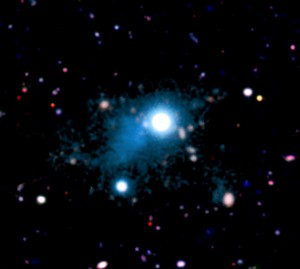
Picture: Sebastiano Cantalupo
Posted
December 12th, 2014 in Announcement, Awards, für externes Zielpublikum
By
Regina Moser|
Comments Off on TOP 10: Cosmic web filament discovery
Teilnahme an der Scientifica 4.-6. Sept. 2015
Thema: Licht
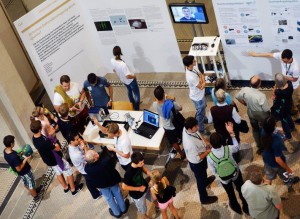
Anmeldung bis 30. Januar 2015: www.scientifica.uzh.ch
Name: Scientifica/PW: sc2015
Für: Präsentation am Stand oder Kurzvorlesung 20 Min.
Support: Regina Moser D-PHYS und Scientifica Projektteam der Hochschulkommunikation
Einblicke: www.scientifica.ch/scientifica-2015
DK Prädentation 12.12.14

Light for Change – Licht für Wandel
http://www.unesco.de/jahr-des-lichts.html
Posted
December 12th, 2014 in Announcement
By
Regina Moser|
Comments Off on Anmeldung Scientifica bis 30. Jan. 2015









